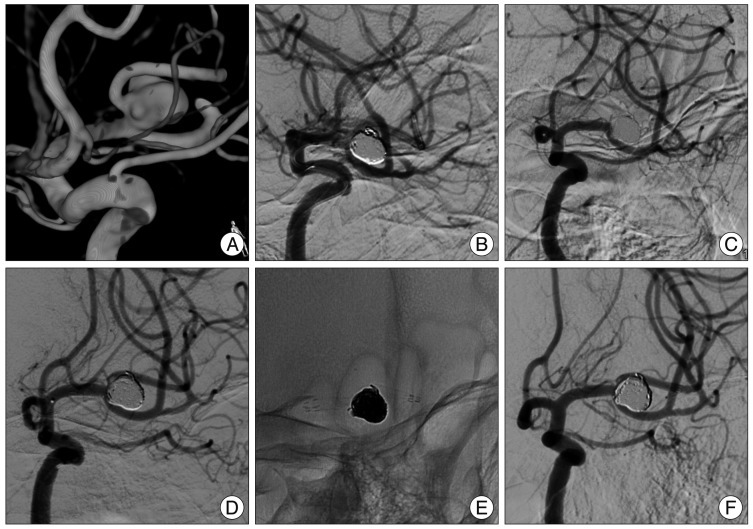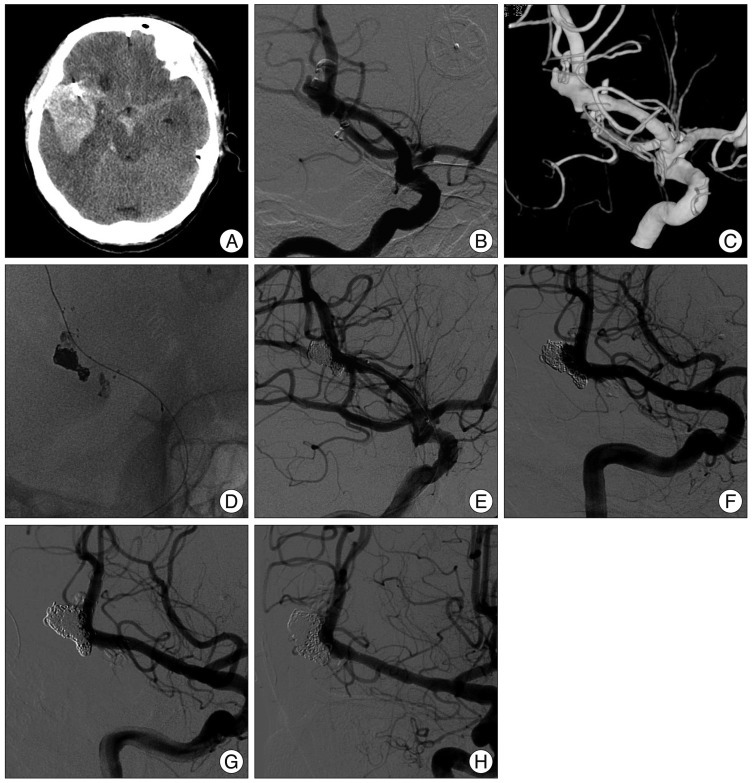J Korean Neurosurg Soc.
2013 May;53(5):274-280. 10.3340/jkns.2013.53.5.274.
Various Techniques of Stent-Assisted Coil Embolization of Wide-Necked or Fusiform Middle Cerebral Artery Aneurysms : Initial and Mid-Term Results
- Affiliations
-
- 1Department of Neurosurgery, Kangbuk Samsung Hospital, Sungkyunkwan University School of Medicine, Seoul, Korea.
- 2Department of Radiology, Kangbuk Samsung Hospital, Sungkyunkwan University School of Medicine, Seoul, Korea. rmh96@dreamwiz.com
- 3Department of Radiology, Severance Hospital, Yonsei University College of Medicine, Seoul, Korea.
- KMID: 1426194
- DOI: http://doi.org/10.3340/jkns.2013.53.5.274
Abstract
OBJECTIVE
To evaluate the feasibility and clinical and angiographic outcomes of stent-assisted embolization for complex middle cerebral artery (MCA) aneurysms.
METHODS
The records of 23 consecutive patients with 24 MCA aneurysms, who underwent stent-assisted embolization of the aneurysm, were retrospectively evaluated.
RESULTS
Fifteen aneurysms were treated with one stent and 8 were treated using more than two stents (5 a stent-within-a-stent, 1 triple stents, and two Y-stent). Angiographically, complete or near complete occlusion was achieved in 15 aneurysms (65.2%), residual neck in five (21.7%), and residual aneurysm in three (13.1%). Five aneurysms demonstrated thrombosis within the stent during the procedure and hospitalization, and were resolved by intraarterial and intravenous Tirofiban injection. Symptomatic thromboembolic complications were developed in five patients and permanent deficits demonstrated in two patients with modified Rankin Scale 1 and 2, respectively. Treatment-related permanent morbidity and mortality rates were 8.3% and 0% with relatively high complication rate. Angiographic follow-up was available in 17 aneurysms at 6-31 months (mean, 13.2 months) and showed stable or improved in 15 (88.2%) and major and minor recurrence in one, respectively.
CONCLUSION
Complex MCA aneurysms could be treated by stent-assisted coiling and showed lower recanalization rate during mid-term follow-up by effective flow diversion due to various stent-assisted techniques. Our results warrant further study with a longer follow-up period in a larger sample.
MeSH Terms
Figure
Reference
-
1. Akpek S, Arat A, Morsi H, Klucznick RP, Strother CM, Mawad ME. Self-expandable stent-assisted coiling of wide-necked intracranial aneurysms : a single-center experience. AJNR Am J Neuroradiol. 2005; 26:1223–1231. PMID: 15891189.2. Baxter BW, Rosso D, Lownie SP. Double microcatheter technique for detachable coil treatment of large, wide-necked intracranial aneurysms. AJNR Am J Neuroradiol. 1998; 19:1176–1178. PMID: 9672035.3. Benitez RP, Silva MT, Klem J, Veznedaroglu E, Rosenwasser RH. Endovascular occlusion of wide-necked aneurysms with a new intracranial microstent (Neuroform) and detachable coils. Neurosurgery. 2004; 54:1359–1367. discussion 1368. PMID: 15157292.
Article4. Bracard S, Abdel-Kerim A, Thuillier L, Klein O, Anxionnat R, Finitsis S, et al. Endovascular coil occlusion of 152 middle cerebral artery aneurysms : initial and midterm angiographic and clinical results. J Neurosurg. 2010; 112:703–708. PMID: 19852536.
Article5. Darsaut T, Salazkin I, Ogoudikpe C, Gevry G, Bouzeghrane F, Raymond J. Effects of stenting the parent artery on aneurysm filling and gene expression of various potential factors involved in healing of experimental aneurysms. Interv Neuroradiol. 2006; 12:289–302. PMID: 20569585.
Article6. Fields JD, Brambrink L, Dogan A, Helseth EK, Liu KC, Lee DS, et al. Stent assisted coil embolization of unruptured middle cerebral artery aneurysms. J Neurointerv Surg. 2013; 5:15–19. PMID: 22170820.
Article7. Fiorella D, Albuquerque FC, Masaryk TJ, Rasmussen PA, McDougall CG. Balloon-in-stent technique for the constructive endovascular treatment of "ultra-wide necked" circumferential aneurysms. Neurosurgery. 2005; 57:1218–1227. discussion 1218-1227. PMID: 16331170.
Article8. Heros RC, Fritsch MJ. Surgical management of middle cerebral artery aneurysms. Neurosurgery. 2001; 48:780–785. discussion 785-786. PMID: 11322438.
Article9. Hwang G, Park H, Bang JS, Jin SC, Kim BC, Oh CW, et al. Comparison of 2-year angiographic outcomes of stent- and nonstent-assisted coil embolization in unruptured aneurysms with an unfavorable configuration for coiling. AJNR Am J Neuroradiol. 2011; 32:1707–1710. PMID: 21852378.
Article10. Izar B, Rai A, Raghuram K, Rotruck J, Carpenter J. Comparison of devices used for stent-assisted coiling of intracranial aneurysms. PLoS One. 2011; 6:e24875. PMID: 21966374.
Article11. Kim BM, Kim DI, Park SI, Kim DJ, Suh SH, Won YS. Coil embolization of unruptured middle cerebral artery aneurysms. Neurosurgery. 2011; 68:346–353. discussion 353-354. PMID: 21135721.
Article12. Kwon OK, Kim SH, Oh CW, Han MH, Kang HS, Kwon BJ, et al. Embolization of wide-necked aneurysms with using three or more microcatheters. Acta Neurochir (Wien). 2006; 148:1139–1145. discussion 1145. PMID: 16990989.
Article13. Lawson MF, Newman WC, Chi YY, Mocco JD, Hoh BL. Stent-associated flow remodeling causes further occlusion of incompletely coiled aneurysms. Neurosurgery. 2011; 69:598–603. discussion 603-604. PMID: 21430583.
Article14. Lee BH, Kim BM, Park MS, Park SI, Chung EC, Suh SH, et al. Reconstructive endovascular treatment of ruptured blood blister-like aneurysms of the internal carotid artery. J Neurosurg. 2009; 110:431–436. PMID: 19046039.
Article15. Lee JY, Seo JH, Cho YD, Kang HS, Han MH. Endovascular treatment of wide-neck intracranial aneurysms using a microcatheter protective technique : results and outcomes in 75 aneurysms. AJNR Am J Neuroradiol. 2011; 32:917–922. PMID: 21393400.
Article16. Lopes D, Sani S. Histological postmortem study of an internal carotid artery aneurysm treated with the Neuroform stent. Neurosurgery. 2005; 56:E416. discussion E416. PMID: 15670395.
Article17. Lubicz B, Francois O, Levivier M, Brotchi J, Baleriaux D. Preliminary experience with the enterprise stent for endovascular treatment of complex intracranial aneurysms: potential advantages and limiting characteristics. Neurosurgery. 2008; 62:1063–1069. discussion 1069-1070. PMID: 18580804.
Article18. Maldonado IL, Machi P, Costalat V, Mura T, Bonafe A. Neuroform stent-assisted coiling of unruptured intracranial aneurysms : short- and midterm results from a single-center experience with 68 patients. AJNR Am J Neuroradiol. 2011; 32:131–136. PMID: 20966053.
Article19. Molyneux A, Kerr R, Stratton I, Sandercock P, Clarke M, Shrimpton J, et al. International Subarachnoid Aneurysm Trial (ISAT) of neurosurgical clipping versus endovascular coiling in 2143 patients with ruptured intracranial aneurysms : a randomised trial. Lancet. 2002; 360:1267–1274. PMID: 12414200.
Article20. Moret J, Cognard C, Weill A, Castaings L, Rey A. The "Remodelling Technique" in the treatment of wide neck intracranial aneurysms. Angiographic results and clinical follow-up in 56 cases. Interv Neuroradiol. 1997; 3:21–35. PMID: 20678369.
Article21. Piotin M, Blanc R, Spelle L, Mounayer C, Piantino R, Schmidt PJ, et al. Stent-assisted coiling of intracranial aneurysms : clinical and angiographic results in 216 consecutive aneurysms. Stroke. 2010; 41:110–115. PMID: 19959540.22. Roy D, Milot G, Raymond J. Endovascular treatment of unruptured aneurysms. Stroke. 2001; 32:1998–2004. PMID: 11546888.
Article23. Sedat J, Chau Y, Mondot L, Vargas J, Szapiro J, Lonjon M. Endovascular occlusion of intracranial wide-necked aneurysms with stenting (Neuroform) and coiling : mid-term and long-term results. Neuroradiology. 2009; 51:401–409. PMID: 19241069.
Article24. Stoodley MA, Macdonald RL, Weir BK. Surgical treatment of middle cerebral artery aneurysms. Neurosurg Clin N Am. 1998; 9:823–834. PMID: 9738109.
Article25. Suh SH, Kim BM, Park SI, Kim DI, Shin YS, Kim EJ, et al. Stent-assisted coil embolization followed by a stent-within-a-stent technique for ruptured dissecting aneurysms of the intracranial vertebrobasilar artery. Clinical article. J Neurosurg. 2009; 111:48–52. PMID: 19326976.
Article26. Vendrell JF, Costalat V, Brunel H, Riquelme C, Bonafe A. Stent-assisted coiling of complex middle cerebral artery aneurysms: initial and midterm results. AJNR Am J Neuroradiol. 2011; 32:259–263. PMID: 20966055.
Article27. Vendrell JF, Menjot N, Costalat V, Hoa D, Moritz J, Brunel H, et al. Endovascular treatment of 174 middle cerebral artery aneurysms : clinical outcome and radiologic results at long-term follow-up. Radiology. 2009; 253:191–198. PMID: 19703857.
Article28. Wanke I, Forsting M. Stents for intracranial wide-necked aneurysms : more than mechanical protection. Neuroradiology. 2008; 50:991–998. PMID: 18807024.
Article
- Full Text Links
- Actions
-
Cited
- CITED
-
- Close
- Share
- Similar articles
-
- Preliminary Results of Y-Stent-Assisted Coil Embolization of Wide-Necked Intracranial Aneurysms: 8 Consecutive Patients
- Endovascular Treatment of Cerebral Aneurysms: Coiling Techniques
- Endovascular Treatment of Wide-Necked Intracranial Aneurysms : Techniques and Outcomes in 15 Patients
- A Complicated Case of Endovascular Stent Assisted Coil Embolization of an Aneurysm
- Stent-Assisted Coil Embolization for the Proximal Middle Cerebral Artery Fusiform Aneurysm




